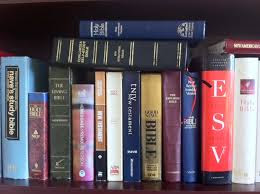New English translations of the Bible are very popular these days. People often ask me which one is best, or which I prefer. The answer is complicated:
- I'm not keen on archaic words in translation, which means I don't use KJV much, or even NIV, which follows it to a certain extent
- Sometimes it's good to expand the meaning of the Hebrew or Greek to make it clearer, especially when there is an assumption made because the original audience would have known something that we don't. It should be implicit information though
- Genre is often ignored by translations. The Bible is rich and varied. We don't want Proverbs to be like a story or sermon. They're supposed to be short and pithy to have greater impact. Hebrew often skips verbs to achieve that. We may not be able to go that far, but translations should keep proverbs as short as possible. Likewise poetry should have rhythm, alliteration and other poetic features, albeit using the richness of the English language rather than Hebrew. Psalms should be singable, or at least sound beautiful when read out loud
- Dynamic (meaning-based) translations don't necessarily have to be low style (colloquial). It depends on the audience, and desired use of the the translation. The REB is an example of a dynamic translation that has good literary style but also sounds good when read out loud
- We may not agree with the theological and/or political ('hot' topics) presuppositions of the translators. Key terms like 'atonement' are important and, if poorly chosen, without input from key stakeholders, may cause a translation to be rejected, as the TNIV was when it first came out. People weren't ready for it
All in all we need different translations for different purposes. In English we have the luxury of choosing e.g. ESV for Bible study and NLT for reading narrative, but morphing to NJB for Psalms. How lucky we are! Many people don't have access to even one good translation.
Key
ESV: English Standard Version
KJV: King James Version
NIV: New International Version
NJB: New Jerusalem Bible
NLT: New Living Translation
REB: Revised English Bible
TNIV: Today's NIV

Comments
Post a Comment